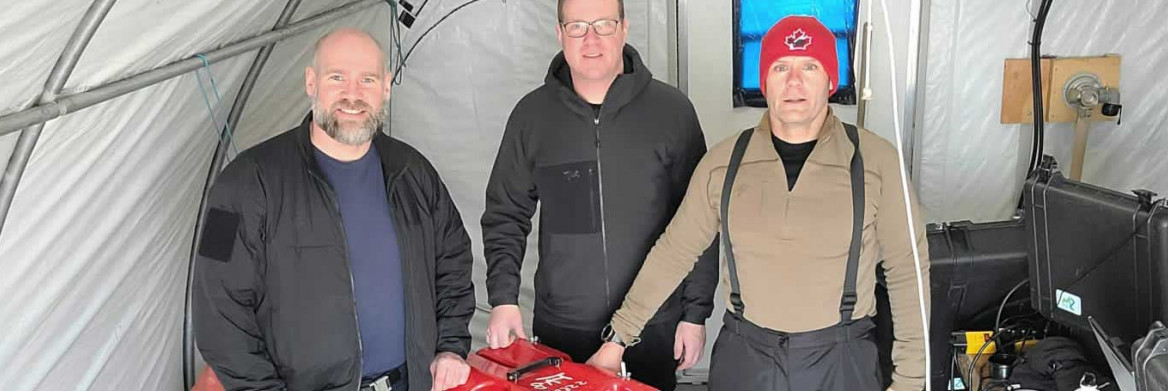Content warning: loss of life
A heavy-equipment operator and father of two young children died in January after his bulldozer crashed through the Arctic ice near a mine in western Nunavut.
No one wanted to leave him under the ice.
So, days after the accident and more than 2,000 kilometres away in British Columbia, RCMP divers were asked to fly north and make every effort to recover his body for his family.
"People know their loved one is gone but they want the closure of being able to say goodbye, see that person one last time and tell them that you loved them,
" says Cpl. Steve Wells, a member of the RCMP's National Underwater Recovery Training Centre (NURTC). "Knowing that there was an expectation by family, friends, and co-workers that we'd recover him made failure not an option.
"
Extreme conditions
The fatal accident happened in waters that were 159 metres deep — a depth that exceeds RCMP divers' capabilities. Some divers, however, are trained to use remotely operated vehicles (ROVs) equipped with GPS, sonar, high-definition video cameras and specialized lighting that can function in extreme cold weather.
The B.C. RCMP Underwater Recovery Team, including Cst. Tim Cucheran, were called in to complete what would be the RCMP's deepest underwater recovery and its first operational call for an ROV above the Artic Circle.
They worked near the Sabina Gold and Silver Corp.'s Back River project, where the bulldozer operator was a friend to many of the employees. Mine operators erected a heated tent for the officers to ward off the outside temperatures that fluctuated between -20 C and -50 C. During one of the first recovery attempts in February, the ROV became entangled in a rope that was set up to help guide the device, which is about the size of a hockey bag. "Until we had eyes on the bulldozer, there were a lot of unknowns,
" says Cucheran.
What Cucheran did know was that he needed another ROV to get the other one out and complete the recovery.
A trial run before the dive
Cucheran requested the use of the National Underwater Recovery Training Centre's ROV to recover the bulldozer driver and the other trapped ROV. The NURTC's advanced ROV includes a five-axis articulated robot arm that provides operators with multiple options when performing underwater tasks.
As the supervising co-ordinator on both trips, Cucheran made the logistical decision to conduct a trial run of the recovery operation in British Columbia before the team returned north for the actual recovery.
"Because of how the bulldozer was positioned, I knew having a dry run would be the best way to prepare,
" says Cucheran, who is based in Delta, B.C.
He arranged to have the ROV suspended by a crane over the same model of bulldozer at a dealership in Surrey, B.C., so that Wells, the ROV operator, could simulate approaching the heavy equipment as if it were in the ocean.
During the trial run, they identified which parts of the bulldozer the ROV could grab for support, learned how to navigate around the cab and, more importantly, recognized an outside latch that had to be down in order for the cab door to remain open.
"If the ROV got in the cab and the door closed behind it, that would have caused another problem we'd have to overcome,
" says Wells.
One day after the simulation on dry land, three officers were on a flight north and that same afternoon they had the NURTC's ROV in the Arctic Ocean to analyze the scene.
Delicate task
NURTC team members Cpl. Todd Kaufmann and Wells ran the ROV, named "Fab" in honour of RCMP Cst. Fabrice Gevaudan, an underwater recovery diver who was killed during the 2014 Moncton shootings.
Using one of the arm's grippers that was embedded with a blade, Kaufmann cut through the rope that entangled the first ROV.
On Day 2, they turned their attention to the recovery.
With Wells operating the NURTC's ROV, Kaufmann guided the robot arm to delicately and precisely move the driver, who was wearing heavy work clothing, through a small space out of the cab, and return his body to the surface. It took a little more than two hours.
"Throughout the operation I'm focused on the screen and keeping the ROV in position so Todd can do his work,
" says Wells, who credited the dry-land practice for the team's achievement.
"That was something we don't normally do, and it really set us up to succeed. It was a huge relief to get the driver out of the cab and back to the surface.
"
Want more
You might be interested in our Q&A with two RCMP underwater recovery divers.
